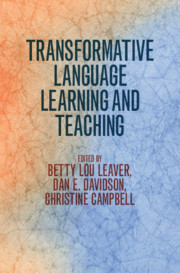Book contents
- Transformative Language Learning and Teaching
- Transformative Language Learning and Teaching
- Copyright page
- Contents
- Figures
- Tables
- Contributors
- Foreword
- Acknowledgments
- Abbreviations
- 1 Introduction
- Part I Theoretical Framework
- Part II Transformative Language Learning and Teaching Applications in Government Programs
- Part III Transformative Language Learning and Teaching Applications in University Programs
- Part IV Transformative Language Learning and Teaching Applications in Immersion Programs
- Part V The Learner
- Part VI Faculty Development
- Part VII Assessment
- 23 Identifying and Evaluating Transformative Learning in the Language Classroom
- 24 Testing and Transformative Language Learning
- 25 Assessing Students in a Transformative Learning Program
- References
- Index
25 - Assessing Students in a Transformative Learning Program
from Part VII - Assessment
Published online by Cambridge University Press: 26 January 2021
- Transformative Language Learning and Teaching
- Transformative Language Learning and Teaching
- Copyright page
- Contents
- Figures
- Tables
- Contributors
- Foreword
- Acknowledgments
- Abbreviations
- 1 Introduction
- Part I Theoretical Framework
- Part II Transformative Language Learning and Teaching Applications in Government Programs
- Part III Transformative Language Learning and Teaching Applications in University Programs
- Part IV Transformative Language Learning and Teaching Applications in Immersion Programs
- Part V The Learner
- Part VI Faculty Development
- Part VII Assessment
- 23 Identifying and Evaluating Transformative Learning in the Language Classroom
- 24 Testing and Transformative Language Learning
- 25 Assessing Students in a Transformative Learning Program
- References
- Index
Summary
Assessment of transformative learning is challenging because key aspects of the transformative experience are often difficult for faculty to recognize and for students to communicate. Also, there is an affective component involved in the struggles students face when encountering disorienting dilemmas and the subsequent perspective shifts that must occur to accommodate new ways of making sense of self, others, and the world. There are ways to track and measure student progress across an arc of development in those important beyond-disciplinary and life skills and mindsets that are the hallmarks of good employees, entrepreneurs, artists, citizens, and family members – humans that are, in short, creators, not just consumers. Faculty generally must be trained in this process because creating good reflective prompts and spotting individual students’ idiosyncratic expressions as they attempt to put into words felt shifts of worldview are not typically part of PhD curricula. One Midwestern, regional state university in the US has met the challenge of eliciting and assessing transformative learning. Lessons learned and specific, replicable processes and tools are shared in this chapter.
- Type
- Chapter
- Information
- Transformative Language Learning and Teaching , pp. 238 - 249Publisher: Cambridge University PressPrint publication year: 2021

